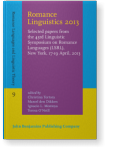Romanian tough-constructions and multi-headed constituents
Ion Giurgea | The ‘Iorgu Iordan - Alexandru Rosetti’ Institute of Linguistics of the Romanian Academy, Bucharest
I propose an account for the absence of agreement on tough-words in Romanian tough- constructions (TCs). I argue that absence of agreement cannot be explained by an A-bar movement derivation, because Romanian TCs involve A-movement, the non-finite complement having passive properties. I also argue against an adverb analysis of Romanian tough-words and against a subject analysis of the clausal argument of the tough-word. I propose a novel analysis, which is supported by West Germanic data: non-agreeing TCs are multi-headed constituents, in which the adjective is the internal head, selecting the supine CP, and the supine C is the external head. Since the adjective is not the external head, it cannot take part in agreement relations involving the [Adjective+Supine] constituent. I provide a technical implementation of the notion of multi-headed constituents which relies on Citko’s (2008) flexible label projection: in this case, it is the label of the complement that projects (an instance of Project-Goal). Finally, I discuss the correlation between the availability of multi-headed TCs and the morphological (in)distinctness between adjectives and adverbs.
References (37)
References
Baker, Mark. 2003. Lexical Categories. Cambridge University Press. 

Bhatt, Rajesh. 1999. Covert Modality in Non-Finite Contexts. Ph.D. Diss., University of Pennsylvania
Bhatt, Rajesh. 2002. “The Raising Analysis of Relative Clauses: Evidence from Adjectival Modification.” Natural Language Semantics 10: 43-90. 

Bobaljik, Jonathan and Samuel Brown. 1997. “Interarboreal Operations: Head Movement and the Extension Requirement.” Linguistic Inquiry 28: 345-356.
Bowers, John. 1993. “The Syntax of Predication.” Linguistic Inquiry 24: 591-656.
Bruening, Benjamin. 2013. “By-Phrases in Passives and Nominals.” Syntax 16(1): 1–41. 

Chomsky, Noam. 2000. “Minimalist Inquiries.” In Step by Step: Essays on Minimalist Syntax in Honor of Howard Lasnik, ed. by Roger Martin, David Michaels, Juan Uriagereka, Samuel Jay Keyser, 89–156. MIT Press, Cambridge, MA.
Citko, Barbara. 2005. “On the Nature of Merge: External Merge, Internal Merge, and Parallel Merge.” Linguistic Inquiry 36: 475-497. 

Citko, Barbara. 2008. “Missing Labels.” Lingua 118: 907-944. 

Citko, Barbara. 2011. “Multidominance.” Linguistic Minimalism, ed. by Cedric Boeckx, 119-142. Oxford: Oxford University Press.
Corver, Norbert. 2000. “Degree Adverbs as Displaced Predicates.” Rivista di Linguistica, 12:1. 155-191.
Collins, Chris. 2005. “A Smuggling Approach to the Passive in English.” Syntax 8: 81-120. 

Cornilescu, Alexandra and Ion Giurgea. 2013. “The Adjective.” A Reference Grammar of Romanian. I: The Noun Phrase, ed. by Carmen Dobrovie-Sorin and Ion Giurgea, 355-530. Amsterdam & Philadelphia: John Benjamins. 

Cornilescu, Alexandra, Carmen Dobrovie-Sorin, Ion Giurgea, Elena Soare, and Camelia Stan. 2013. “Deverbal Nouns.” A Reference Grammar of Romanian. I: The Noun Phrase, ed. by Carmen Dobrovie-Sorin and Ion Giurgea, 663-718. Amsterdam & Philadelphia: John Benjamins. 

Donati, Valentina. 2006. “On Wh-head Movement.” In Wh-Movement. Moving On, ed. by Lisa Cheng and Norbert Corver, 21–46. MIT Press.
Dragomirescu, Adina. 2013. Particularităţi sintactice ale limbii române în context romanic. Supinul. Bucharest: Editura Muzeului Naţional al Literaturii Române.
Dye, Cristina. 2006. “A- and Ā-Movement in Romanian Supine Constructions.” Linguistic Inquiry 37(4): 665-674 

Giurgea, Ion. 2011. The Romanian verbal cluster and the theory of head movement. In ed.) Anna Maria Di Sciullo, Romance Linguistics 2010. Selected papers from the 40th Linguistic Symposium on Romance Languages (LSRL), Seattle, Washington, March 2010, 271-286. Amsterdam, Philadelphia: John Benjamins. 

Giurgea, Ion and Elena Soare. 2007. “Tough Constructions and Raising Reduced Relatives.” Bucharest Working Papers in Linguistics, IX.1: 124-136.
Giurgea, Ion and Elena Soare. 2010b. “Modal Non-Finite Relatives in Romance.” In Modality and Mood in Romance: Modal interpretation, mood selection, and mood alternation, ed. by Eva-Maria Remberger and Martin Becker, 67-94. De Gruyter.
Hill, Virginia. 2002. “The Gray Area of Supine Clauses.” Linguistics 40: 495–517. 

Iatridou, Sabina, Elena Anagnostopoulou, and Roumyana Izvorski. 2001. “Observations About the Form and Meaning of the Perfect.” In Ken Hale: A Life in Language, ed. by Kenstowicz, Michael, 189-238. Cambridge: MIT Press.
Larson, Richard. 1998. Free Relative Clauses and Missing P’s: Reply to Grosu. Ms., Stony Brook University.
Nunes, Jairo. 2001. “Sideward Movement.” Linguistic Inquiry 32:303-344. 

Nunes, Jairo. 2004. Linearization of Chains and Sideward Movement. Cambridge, MA: MIT Press.
Pană-Dindelegan, G. 1982. Structura sintactică nominal +adverb (sau adjectiv) + supin. Limba Română, 31:5-13.
Pană-Dindelegan, G. 1992. Sintaxă şi semantică. Clase de cuvinte şi forme gramaticale cu dublă natură. Bucharest: Tipografia Universităţii din Bucureşti.
Pană-Dindelegan, G. 2011. Din istoria supinului românesc. In Limba română – ipostaze ale variaţiei lingvistiice, I, ed. by R. Zafiu, C. Uşurelu, H. Bogdan Oprea, 119-130. Bucharest: Editura Universităţii din Bucureşti.
van Riemsdijk, Henk. 2006. “Grafts Follow from Merge.” In Phases of Interpretation, Mara Frascarelli, 17-44. De Gruyter. 

Roberts, Ian. 2010. Agreement and Head Movement: Clitics, Incorporation and Defective Goals. Cambridge, MA: MIT Press. 

Soare, Elena. 2002. Le supin roumain et la théorie des catégories mixtes. PhD dissertation, University of Paris 7.
Soare, Elena. and Carmen Dobrovie-Sorin. 2002. “The Romanian Supine and Adjectival Complementation. Tough Constructions.” Bucharest Working Papers in Linguistics 4(1): 75-87.
Vişan, Ruxandra. 2004. “The Cât de / Cum…de Exclamative Patterns in Romanian.” Bucharest Working Papers in Linguistics, 6:1.
Cited by (3)
Cited by three other publications
Giurgea, Ion & Elena Soare
2020.
Agree or not: Tough choice. A study of Tough -constructions in Romanian in a comparative perspective.
Langages N° 218:2
► pp. 39 ff.

Tayalati, Fayssal & Lieven Danckaert
2020.
The syntax and semantics of Modern Standard Arabic resumptivetough-constructions.
Folia Linguistica 54:1
► pp. 197 ff.

Tayalati, Fayssal, Vassil Mostrov & Danièle Van de Velde
2020.
Les constructions Tough : syntaxe, sémantique et interfaces. Présentation.
Langages N° 218:2
► pp. 7 ff.

This list is based on CrossRef data as of 25 july 2024. Please note that it may not be complete. Sources presented here have been supplied by the respective publishers.
Any errors therein should be reported to them.
